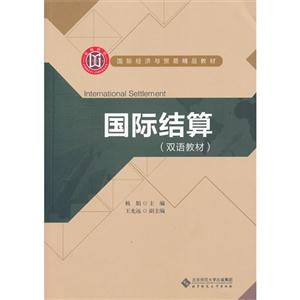-
>
中医基础理论
-
>
高校军事课教程
-
>
思想道德与法治(2021年版)
-
>
毛泽东思想和中国特色社会主义理论体系概论(2021年版)
-
>
中医内科学·全国中医药行业高等教育“十四五”规划教材
-
>
中医诊断学--新世纪第五版
-
>
中药学·全国中医药行业高等教育“十四五”规划教材
国际结算-双语教材 版权信息
- ISBN:9787303142187
- 条形码:9787303142187 ; 978-7-303-14218-7
- 装帧:一般胶版纸
- 册数:暂无
- 重量:暂无
- 所属分类:>
国际结算-双语教材 本书特色
《国际结算·双语教材》的初衷是为本科生提供一个全面、系统介绍国际结算理论和实务知识的双语教材。《国际结算·双语教材》不仅介绍了基本概念和基本理论,还包含具体实务操作流程和风险防范。运用大量实际案例解释原理,并对相关术语进行解释和分析,强调具体操作过程中相应的英语表达。
国际结算-双语教材 内容简介
《国际结算·双语教材》以国际商会的惯例或出版物为基础,全面系统地介绍了与国际结算相关的单据、票据、融资、主要结算方法(如汇款、托收、信用证),其他结算方法(保函、保理、福费廷等)以及贸易术语等内容。不仅概括性地介绍了当前国际结算比较前沿的理论,还引入了一些前沿性的实务操作案例。特别是对在信息技术的支持下出现的电子支付工具、电子单证等都进行了阐述。
国际结算-双语教材 目录
chapter 1 introduction
(learning objectives) 1
1.1 the concept of international settlement
1.2 the categories of international settlement
1.3 the risks involved in international settlement
1.3.1 product production and transport risks
1.3.2 credit risks
1.3.3 adverse business risks
1.3.4 political risks
1.3.5 financial risks
1.3.6 foreign exchange risks
1.4 parties and their roles
1.5 the application of international payment
1.5.1 payment in advance
1.5.2 credit transactions
1.5.3 collection
1.5.4 letter of credit (l/c)
1.5.5 letter of guarantee and standby l/c
1.6 evolution of international payment
1.6.1 from cash settlement to instruments settlement
1.6.2 from direct payment between traders to payment effectedthrough a financial intermediary
1.6.3 from goods trading to documents trading
1.6.4 from paper documentary settlement to electronic documentarysettlement
1.7 international rules and practice
chapter 2 international payment and clearing system
(learning objectives)
2.1 payment system
2.1.1 e-commerce payment system
2.1.2 clearing process
2.2 swift
2.2.1 introduction
2.2.2 characteristics
2.2.3 types of swift message
2.3 some major payment system
2.3.1 chips
2.3.2 fedwire
2.3.3 chaps
2.3.4 target
2.4 correspondent banks in international settlement
2.4. 1 banking institutions
2.4.2 correspondent bank
2.4.3 depository banks
chapter 3 instruments of international settlement
(learning objectives)
3.1 an overview of negotiable instruments
3.1.1 definition of a negotiable instrument
3.1.2 chief features of a negotiable instrument
3.1.3 parties to a negotiable instrument
3.1.4 negotiable instrument laws
3.2 bill of exchange
3.2.1 definition of a bill of exchange
3.2.2 contents of a bill of exchange
3.2.3 parties to a bill of exchange
3.2.4 classification of bill of exchange
3.2.5 acts relating to a bill of exchange
3.3 promissory note
3.3.1 definition of a promissory note
3.3.2 parties & characteristics of a promissory note
3.3.3 contents of a promissory note
3.3.4 classification of promissory:note
3.3.5 difference between a bill and a note
3.4 check
3.4.1 definition of a check
3.4.2 contents & features of a check
3.4.3 parties to a check
3.4.4 classification of check
3.4. 5 check clearing & dishonor
3.4.6 difference between a check and a bill of exchange
3.5 other negotiable instruments
(summary)
(case study)
chapter 4 remittance/50
(learning objectives)
4. 1 outlines of remittance
4.1.1 definition of a remittance
4.1.2 parties to a remittance
4.1.3 types of remittance
4.2 procedure of remittance and comparison of m/t, t/t, andd/d
4.2.1 procedure of remittance
4.2.2 comparison of m/t, t/t, and d/d
4.3 reimbursement of remittance cover and refund
4.3.1 reimbursement of remittance cover
4.3.2 cancel the remittance or refund the imbursement
4.4 the function of remittance in international trade
4.4.1 payment in advance
4.4.2 payment after arrival of goods
(summary)
(case study)
chapter 5 collection
(learning objectives)
5.1 outlines of collection
5.1.1 definition of a collection
5.1.2 parties to a collection
5.1.3 types of collection
5.2 documentary collection practice
5.2.1 procedures of documentary collection
5.2.2 terms of releasing documents
5.2.3 collection instruction
5.2.4 liabilities and disclaimers of banks
5.3 risk protection and financing under collection
5.3.1 risk and protection for exporters and importers
5.3.2 financing under the collection
(summary)
(case s
- >
有舍有得是人生
有舍有得是人生
¥17.1¥45.0 - >
苦雨斋序跋文-周作人自编集
苦雨斋序跋文-周作人自编集
¥6.9¥16.0 - >
推拿
推拿
¥12.2¥32.0 - >
姑妈的宝刀
姑妈的宝刀
¥9.0¥30.0 - >
罗庸西南联大授课录
罗庸西南联大授课录
¥13.8¥32.0 - >
月亮与六便士
月亮与六便士
¥15.1¥42.0 - >
巴金-再思录
巴金-再思录
¥14.7¥46.0 - >
名家带你读鲁迅:故事新编
名家带你读鲁迅:故事新编
¥13.0¥26.0





















